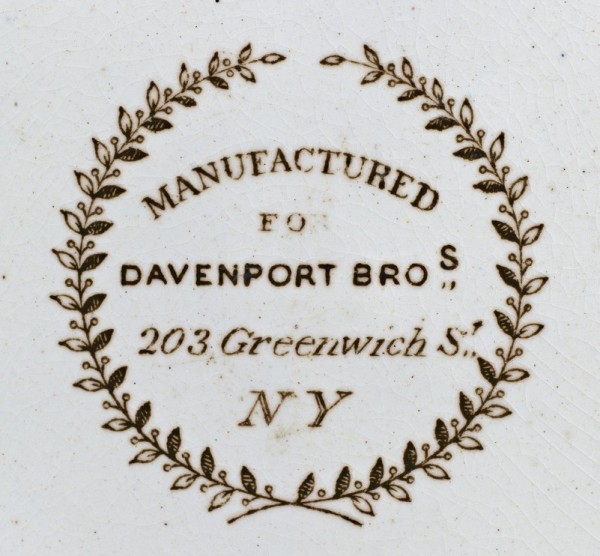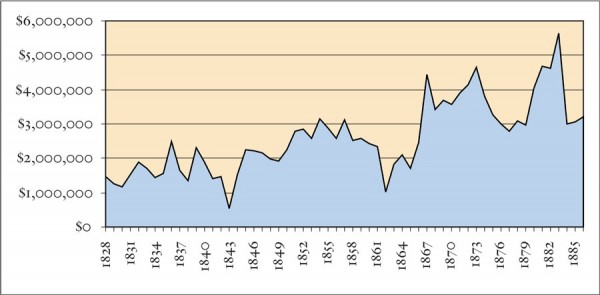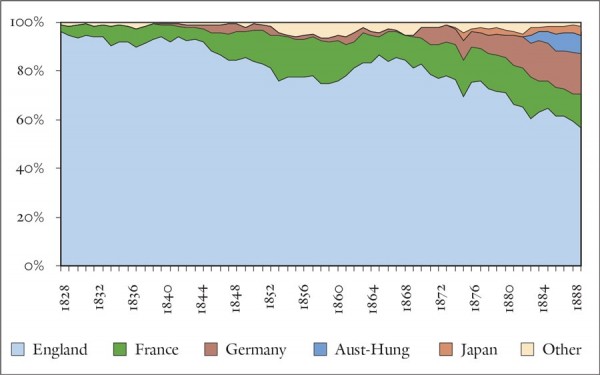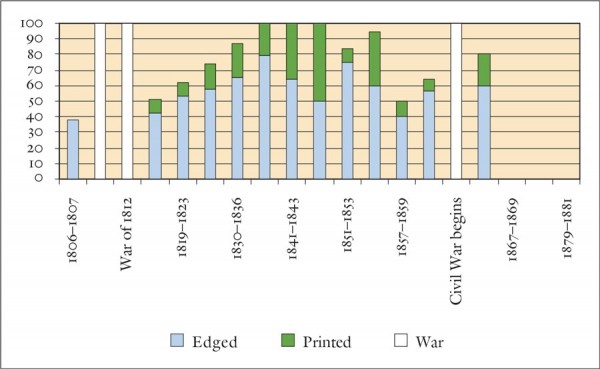
Invoice, Davenport Brothers, New York, 1861. (Authors’ collection; all photos, Gavin Ashworth.)

Plate, England, 1855–1860. Ironstone. D. 8 3/4". Brown printed importer’s mark: “MANUFACTURED / FOR / DAVENPORT BROs../ 203 Greenwich St../ N Y.” Unfortunately, the plate does not bear a potter’s mark or pattern name.

Detail of the mark on the underside of the plate illustrated in fig. 2.

Invoice, Stein, Wanner & Co., Philadelphia, Pennsylvania, 1856. The invoice bears a vignette with a white granite pitcher and lists wares sold to Fahnestock Brothers in Gettysburg, Pennsylvania.

Pitcher, William Adams and Son, Tunstall, Staffordshire, 1850–1860. White granite. H. at handle 10". Mark: printed on underside, American eagle and “SUPERIOR WHITE GRANITE.” This pitcher is very close in form to the one in the center of the vignette on the invoice illustrated in fig. 4.

Invoice, Stirk, Field & Co., Philadelphia, Pennsylvania, March 29, 1861. The vignette shows the facade of the company’s building with a sign for “QUEENSWARE” and, on the street below, a typical Staffordshire crate being unpacked. The invoice is for a list of wares sold to Fahnestock Brothers.

Muffin plate, Joseph Clementson, Shelton and Hanley, Staffordshire, ca. 1839–1855. Whiteware. D. 5". Mark: on underside, printed in brown, “S. FAHNESTOCK / IMPORTER.” Samuel Fahnestock founded the firm that became Fahnestock Brothers in 1855. The plate decoration is the Lucerne pattern.

Detail of the importer’s mark on the underside of the muffin plate illustrated in fig. 7.

Cost of painted teas, edged plates, and dipped bowls as a percentage above the cost of CC ware, 1796–1859: painted teas, edged plates, dipped bowls.

Value of imported English ceramics, 1828–1886. Source: U.S. Treasury Reports

Market share of imported ceramics, 1828–1888. Source: U.S. Treasury Reports

Transcription of a notice dated July 1, 1864, in which D. B. Stedman & Co., Boston, Massachusetts, announced a 50 percent price increase. The original is in the Warshaw Collection of Business Americana-Pottery, Archives Center, National Museum of American History, Smithsonian Institution, Washington, D.C.

Percentage of undecorated teas (CC and White Granite wares) listed in the invoice sample.

Percentage of undecorated plates (CC and White Granite wares) listed in the invoice sample.

Percentage of undecorated bowls (CC and White Granite wares) listed in the invoice sample.

Percentage of decorated teas (Painted and Printed) listed in the invoice sample.

Percentage of decorated plates (Edged and Printed) listed in the invoice sample.

Percentage of decorated bowls (Painted, Dipped, and Printed) listed in the invoice sample.

Bowls, Don Carpentier, East Nassau, New York, ca. 1995. Earthenware. D. of bowl at right 6 1/2". The three bowls shown are reproductions of dipped ware: variegated, fan, and mocha.

Bowls, Staffordshire, ca. 1830–1850 (left), ca. 1850–1880 (right). Whiteware. D. of bowl at left 4 1/2", H. 2 3/4". The bowl at left was turned, the one at right was jiggered.

Saucer, England, ca. 1780–1800. China glaze. D. 4 7/8".

Saucer, Ralph and James Clews, Staffordshire, ca. 1818–1834. Pearlware. D. 6".

Saucer, Staffordshire, ca. 1810–1820. Pearlware. D. 5 1/8". The painted decoration on the border is a classical husk pattern.

Saucer, Staffordshire, ca. 1830– 1835. Whiteware. D. 5 7/8". This example has a thick border of strawberries painted in chrome colors, a more complex design than found in many patterns of the period.

Saucer, Staffordshire, ca. 1845– 1860. D. 5 3/4". The very small sprigs decorating this saucer are painted in chrome colors. On one side the rim has a thicker glaze with a light blue tint—clearly meant to make a whiter ware rather than to imitate Chinese porcelain.

Saucer, England, ca. 1845–1880. Whiteware. D. 5 3/4". The decoration on this saucer was achieved using four different cut sponges, with the exception of the black stem of the plant, which was painted by hand.

Percentage above the cost of CC ware for printed teas, plates, and bowls.

The changing cost relationship between CC, shell-edged, and printed plates.

Average discounts on 122 Staffordshire invoices for ceramics exported to America.

Plate, John Turner, Lane End, Staffordshire, ca. 1790–1806. China glaze. D. 7 3/4". Turner went bankrupt in 1806.

Plate, probably J. and R. Riley, Burslem, 1814–1828. Pearlware. D. 9 7/8".

Plate, Staffordshire, ca. 1818–1830. Pearlware. D. 10 1/8". The plate has a rim blemish, which would have made it a “second” in quality.

Plate, S. & S., ca. 1845–1860. Ironstone. D. 10 1/2". Marks: impressed on underside, “KERR’S / OLD CHINA HALL / PHILA.”; printed in blue on underside, “ONTARIO / S & S” within decorative border. “Ontario” refers to the pattern.

Detail of the mark on the underside of the plate illustrated in fig. 33.

Plate, Livesley Powell & Co., Hanley, Staffordshire, 1851–1866. Whiteware. D. 9". The Rose and Bell sheet pattern is printed in purple with red and blue painted highlights.

Plate, Staffordshire, ca. 1860–1870. Ironstone. D. 9 1/2". Marks: None. The plate’s border is decorated with floral sprays, and the center shows a group of floral sprays with a flag, plus a liberty cap vignette that was commonly used during the Civil War.
